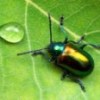Meinertellidae! It's a jumping bristletail. In California these flightless insects are common around harvester ant nests. I don't think they have any sort of specialized relationship with ants, except perhaps finding the warm microclimate of the mound surface agreeable.
Wings are an ancient adaptation, and most of our modern flightless insects represent an evolutionary loss of function from their flighted forebears. Not so with jumping bristletails. This group diverged from the remaining insects prior to the advent of wings- their line of ancestry has been earthbound since the beginning.
The multi-talented Ainsley picked the ID first, with Pete Yeeles a close second. So, 10 points, and 5 points. Or something.
More like this
Effects Of Stress Last For Life In Birds:


Alex, I would like to redeem my points for a nice close-up photo of the next leiodid you run across. Or more staphylinoids in general!
Sounds like a deal! I don't run into Leiodids very often, though. Is there a fail-safe Leiodid-hunting trick?